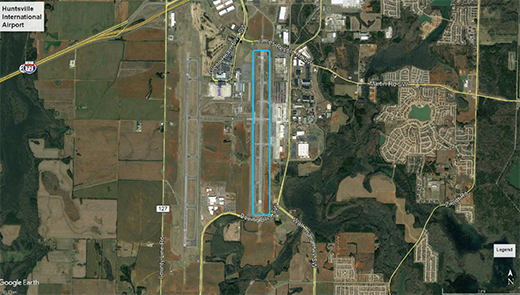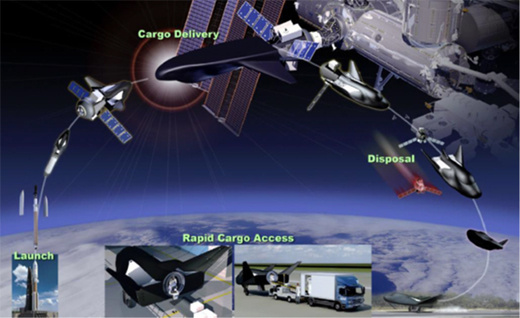Proposed Huntsville Commercial Space Reentry Operations
Huntsville International Airport (HSV)
HSV is located in Madison County, Alabama, about 9 miles southwest of downtown Huntsville. Serving more than 1.2 million passengers each year, HSV is the largest commercial airport in northern Alabama. HSV spans about 6,000 acres (see below for an image of HSV). HSV offers and receives flights from nine major cities including Atlanta, Charlotte, Chicago, Dallas, Denver, Detroit, Houston, and Dulles and Washington D.C.
Currently, the Authority is proposing to offer HSV as a reentry site for Sierra Space's proposed operations as described below. Should additional reentry vehicle operators express interest in HSV as their reentry site, the additional reentry vehicle operators would need to apply to the FAA for a vehicle operator license, and the Authority would need to modify its Reentry Site Operator License. For more information, visit the FAA License Review Process page.
Proposed reentry operations would occur at Runway 18L/36R, circled in blue in the aerial image of HSV below. As reentry vehicle operations would be confined to this area, the blue line also marks the proposed reentry site boundary.

Huntsville International Airport and proposed reentry site
Sierra Space Proposed Operations of the Dream Chaser
Sierra Space is developing the Dream Chaser, a reusable reentry vehicle capable of carrying payloads to and from low Earth orbit, including delivering supplies to the International Space Station under the Commercial Resupply Services 2 (CRS-2) contract with the National Aeronautics and Space Administration.
The below image shows Sierra Space's proposed operations. The Dream Chaser vehicle would be carried as payload on a vertically-launched United Launch Alliance Atlas 5. HSV does not support vertical launches of space vehicles; therefore, launch activities would occur at another site, such as Cape Canaveral. Sierra Space proposes that the Dream Chaser vehicle would deliver up to 5,500 kilograms of pressurized and unpressurized cargo to the International Space Station. Sierra Space would also offer disposal services over the open ocean via a transport vehicle that could separate from Dream Chaser and burn up safely in the Earth's atmosphere.
The Dream Chaser vehicle's reentry trajectories from orbit would be dependent on the specific mission being flown and would be defined prior to launch. During the reentry sequence, Dream Chaser would have set reentry windows, or timeframes, to begin descent into the Earth's atmosphere to meet the designated reentry trajectory. If No-Go criteria are met, the Dream Chaser vehicle would remain in orbit until the specific reentry trajectory could be received or a contingency trajectory is called upon.
The reentry vehicle would reenter from the south on an ascending trajectory, with high atmospheric overflight of the southwestern U.S. or Central American countries, before landing at HSV. The reentry vehicle would remain above 60,000 feet altitude above mean sea level for the majority of the overflight of Texas, Arkansas, Louisiana, Mississippi, and Alabama. The reentry vehicle would descend below 60,000 feet altitude above mean sea level approximately 10 to 20 miles from HSV prior to landing and would operate below 60,000 mean sea level for about three to four minutes.

A complete proposed mission of Sierra Space's Dream Chaser vehicle
